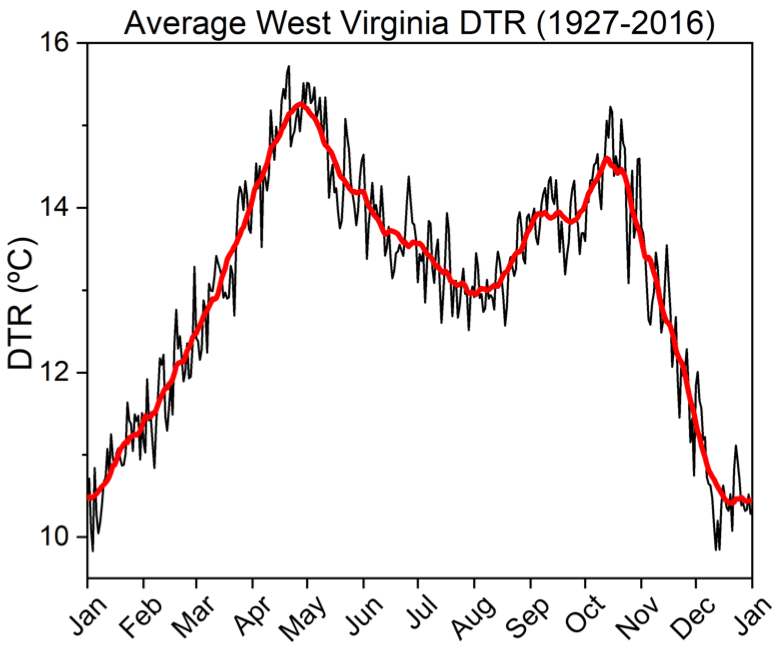A changing climate is expected to negatively impact agriculture by making water supplies less predictable and energy more expensive. Some aspects of a changing climate may present opportunities to increase productivity in West Virginia (WV) and the Appalachian region of the United States. Hay is WV’s most valuable crop and is produced on about 16% West Virginia’s farmland (3.6 million acres; USDA NASS). The average hay yield in WV was 30.1% lower than the national average from 1909-2017 (USDA NASS). This difference between state and national averages suggests that technological advancements (e.g. irrigation, fertilizer, or new cultivars) either haven’t been fully adopted or aren’t suitable for adaptation to changes in WV’s climate.
Over the past century, WV’s climate has become wetter with milder temperatures.
For example, between 1906 and 2016 maximum temperatures actually decreased 5.3%, while minimum temperatures increased 7.7%. Within this same period, precipitation increased 2.2%. Much of the country is looking for plant cultivars that are more tolerant of drought and heat (Marshall et al. 2015), but that is likely not the change needed in WV.
Temperature trends suggest a decreased diurnal temperature range (DTR), defined as the difference between daily maximum and minimum temperatures (Dai et al. 1999). DTR peaks twice annually, during both spring and fall, corresponding with the beginning and end of each growing season (Durre and Wallace 2001). The DTR has decreased in WV for three consecutive climate periods (Table 1) suggesting increasing relative humidity that slows evaporation and transpiration that may increase frequency of excessive soil moisture. Additionally, increasing relative humidity is consistent with increased cloudiness, soil moisture, and precipitation (Dai et al. 1999). Therefore, changes in DTR can provide information about the length and potential productivity of the growing season (i.e. relative humidity and available sunlight) and may also aid in crop or cultivar selection.
-
Descriptive statistics of daily diurnal temperature range observations averaged spatially (n = 18) across West Virginia, USA for three consecutive climate periods. note: St. Dev. = Standard Deviation

-
Seasonal maximum and minimum diurnal temperature ranges (DTR; ºC) and dates of occurrence for three consecutive climate periods.

-
Diurnal temperature range (DTR; ºC) averaged daily between 1927 and 2016. Red line represents 3-week centered moving average.

Changes in the timing and magnitude of annual DTR patterns represent agriculturally relevant changes in climate that may help farmers refine their management practices.
The annual pattern of DTR shows two minima on December 21 and August 2 and two maxima on April 28 and October 13 (Figure 1). This suggests a growing season length of 168 days when averaged across 18 West Virginia locations between 1927 and 2016 (Figure 1). However, between 1987 and 2016 the spring and fall maximums occurred on April 21 and October 26, respectively suggesting that West Virginia's growing season length increased by 20 days (Table 2). The magnitude of all four seasonal DTR minimums or maximums decreased in WV suggesting year-round increases in relative humidity (Table 2). Large decreases (> 1.0ºC) in DTR occurred during summer and fall seasons (Table 2), which likely represents substantially increased in cloud cover.
Alternatively, smaller DTR decreases (< 0.5ºC) during the winter and spring (Table 2) suggest more balanced effects from increased cloud cover, precipitation, and soil moisture. However, it should be noted that state averages shown here mask the rugged terrain of the “Mountain State” that results in complex spatial patterns of local growing season length, cloud cover, precipitation, and relative humidity. In summary, changes in DTR over the past 90 years suggest a 20 day increase in growing season length, substantially increased cloud cover during the warm season, and year-round increases in relative humidity.
Long-term changes in the DTR suggest year-round increases in relative humidity that slows evaporation and transpiration and may prolong periods of excessive soil moisture.
Additionally, substantial increases in cloud cover during the warm season, may be reducing the amount of sunlight available for crop growth. Currently, West Virginia’s agricultural sector depends on reliable production of high quality hay that is primarily used as low-cost animal feed, but observed shifts in climate and hay yields indicate opportunities are emerging if farmers strategically adapt to existing challenges. The combination of increasing relative humidity and cloud cover suggests crop and cultivar selection could be biased towards varieties that are tolerant of shade and wet soils.
Alternatively, a lengthening growing season (especially in the fall) may support the selection of higher yielding, longer season varieties and warmer winter temperatures may support a more diverse variety of crops and cropping strategies. For example, high-priced specialty crops (e.g. tea) and double-cropping practices where successive annual crops are harvested in the same growing season may become more feasible. Ultimately, agricultural challenges exist associated with climate change in WV, but continued research is needed to identify adaptive planning and investment strategies that capitalize on emerging opportunities.
-
Dai, A., Trenberth, K.E. and Karl, T.R., 1999. Effects of clouds, soil moisture, precipitation, and water vapor on diurnal temperature range. Journal of Climate, 12(8), pp.2451-2473.
Durre, I. and Wallace, J.M., 2001. The warm season dip in diurnal temperature range over the eastern United States. Journal of Climate, 14(3), pp.354-360.
Marshall, E., Aillery, M., Malcolm, S. and Williams, R., 2015. Agricultural production under climate change: the potential impacts of shifting regional water balances in the United States. American Journal of Agricultural Economics, 97(2), pp.568-588.
United States Department of Agriculture. National Agricultural Statistics Service. Quick Statistics searchable database.
United States Department of Agriculture. National Agricultural Statistics Service. West Virginia Annual Bulletin No. 48. 2017.
United States Department of Agriculture. National Agricultural Statistics Service. 2017 State Agriculture Overview: West Virginia.
-
By Evan Kutta, West Virginia University, Institute of Water Security and Science and Jason A. Hubbart, West Virginia University, Davis College of Agriculture, Natural Resources and Design

